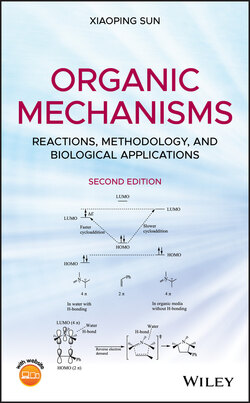Читать книгу Organic Mechanisms - Xiaoping Sun - Страница 37
1.10 ISOTOPE LABELING
ОглавлениеThe enrichment of specific isotope of an element for an atom in a compound molecule is called isotope labeling. It is a very useful technique for studying kinetics and mechanisms for organic reactions. For example, let us first consider the acid‐catalyzed hydrolysis of esters such as ethyl acetate (Reaction 1.69) [1]
(1.69)
From the overall reaction, it is not clear what bond, the acyl‐oxygen bond or the alkyl‐oxygen bond, is broken. Cleavage of either bond could lead to the formation of the products.
In order to establish the mechanism for the reaction, the oxygen atom of the alkoxide group (–OEt) in the ester is labeled (enriched) with the oxygen‐18 isotope (18O) and the hydrolysis of the 18O‐labeld ester is conducted in the same condition (Reaction 1.70):
(1.70)
Et18OH is identified from the products by mass spectrometry, but EtOH is not found. MeCO18OH is not found either [1]. The results unambiguously show that the acyl‐oxygen bond is broken in the reaction giving the observed products. However, the alkyl‐oxygen bond remains intact, as cleavage of the alkyl‐oxygen bond would lead to MeCO18OH, but it is not observed. On the basis of the oxygen‐18 isotope labeling experiment and other supporting data, the reaction mechanism is established and described in Figure 1.18. The acyl–oxygen bond cleavage, unambiguously identified from the isotope labeling experiment, is accomplished via the combination of a nucleophilic addition of water and a subsequent elimination of Et18OH.
Very often, isotope labeling on a compound may alter the rate constants for certain reactions of the compound. This is referred to as the kinetic isotope effects [1, 3]. In principle, a heavier isotope of an element has a lower zero‐point energy. Therefore, a bond to a heavier isotope (such as C─D bond) possesses a lower energy level than a bond to a lighter isotope (such as C─H bond) (Fig. 1.19). More energy is required to break a bond to a heavier isotope (such as C─D bond) than a bond to a lighter isotope (such as C─H bond). Since breaking of a C─H/C─D bond has a late transition state, the difference in energies of the transition states for breaking these bonds is much smaller than the difference in energy levels of the C─H and C─D bonds. Thus, the activation energy for breaking a C─D bond (Ea,D) is greater than that for breaking a C─H bond (Ea,H) (Fig. 1.19). This means the activation energy for a reaction that involves breaking a bond formed on a heavier isotope (such as C─D bond) is greater, corresponding to a smaller rate constant at a given temperature, if (only if) breaking of the bond is the rate‐determining step for the studied reaction. If breaking of this bond occurs prior to or after the rate‐determining step, the kinetic isotope effect is very minor. This effect is most remarkable for substitution of deuterium (D) for hydrogen (H) because the ratio in masses between these two isotopes (D/H = 2) is larger than those for any other pairs of isotopes. In general, if a bond to hydrogen (such as C–H) or deuterium (such as C–D) is being broken in the rate‐determining step of a reaction, the ratio of kH (rate constant for the reaction involving breaking the bond to hydrogen, such as C─H bond) to kD (rate constant for the reaction involving breaking the bond to deuterium, such C─D bond), kH/kD, is typically 2–8. This is termed kinetic deuterium isotope effect. If the kH/kD values are found between 1 and 1.5, the corresponding bond breaking does not occur in the rate‐determining step.
FIGURE 1.18 Reaction mechanism for acid‐catalyzed hydrolysis of the oxygen‐18 isotope labeled ethyl acetate.
FIGURE 1.19 Energetics for C─H and C─D (deuterium) bonds.
Kinetic deuterium isotope effect is often used in studies of the C─H bond functionalization. For example, the radical bromination of toluene (PhCH3) to benzyl bromide (PhCH2Br) has the kinetic isotope effect kH/kD ~ 5 [3]. This shows that breaking of the C─H bond in the methyl group of toluene by a bromine radical (Reaction 1.71) is the rate‐determining step for the overall bromination reaction:
(1.71)
The mechanism of radical halogenations of alkanes will be discussed extensively in Chapter 2.
The electrophilic nitration of benzene by acetyl nitrate (CH3CO2NO2) involves substitution of the aromatic C─H bond by a nitro (–NO2) group (Reaction 1.72) [3]:
(1.72)
Overall, the reaction has the second‐order rate law, first order in benzene and first order in acetyl nitrate (rate = k[C6H6][CH3CO2NO2]). Study of the kinetic isotope effect using fully deuterated benzene C6D6 shows kH/kD = 1 [3]. The data indicate that the C─H bond cleavage is not involved in the rate‐determining step. Instead, the rate‐determining step is the electrophilic attack of the nitrating agent on benzene, which is supported by the observed overall second‐order rate law. Mechanism for the reaction is shown in Figure 1.20. The aromatic nitration and related electrophilic substitution reactions of arenes will be studied in Chapter 5.
FIGURE 1.20 Reaction mechanism for nitration of benzene by acetyl nitrate.
